4.3.5 REGNIER’S ABACUS


Figure18 : for what phase this tool may be useful
The aim of this tool is to obtain the participants’ opinions on a specific subject. It is not the consensus that is sought but rather the exchange and discussion between individuals on their different opinions.
The Regnier’s abacus is an original method, effective, simple and quick based on questions to be asked to stakeholders and/or experts. It can be achieved through workshops, interviews, by post, or online.
The Regnier’s abacus is an excellent communication tool very useful in reducing uncertainties by confronting participant’s opinions. It can also help to find out what the issues or the possible changes are that they consider as likely or otherwise.
This exercise can be achieved during a workshop in 4 steps:
1 >>> In introduction to the workshop, the facilitator explains to the stakeholders the aims of the exercise, distributes to each participants one sheet with items to mark and explains the items if needed. The item must be simple: subject + verb + complement. They can have been identified by stakeholders during a previous workshop or selected by the case study team.

Example of file used during a workshop. In that case, the file was distributed after a discussion about possible approaches of management. The participants had to express their opinion in terms of preferred approach and feasibility of them. ![]()

2 >>> The participants read and mark each item using this notation:
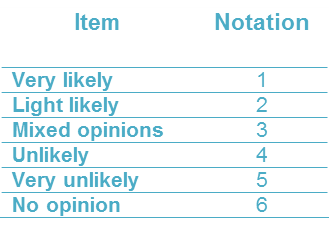
3 >>> Then, the facilitator collects all the individual sheets and integrates the marks in an Excel file prepared in advance (download example here : ![]() ). That will allow the calculation of average results for each item. To do this, a scoring method is used. It provides a score for each notation:
). That will allow the calculation of average results for each item. To do this, a scoring method is used. It provides a score for each notation:
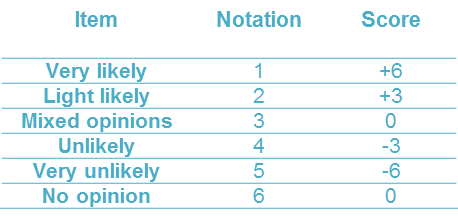
An average is calculated for each item in order to identify and help agree the issues or possible changes that are likely or unlikely, and the issues or possible changes on which there is no consensus.
A colour scale can be used to make the results more visual.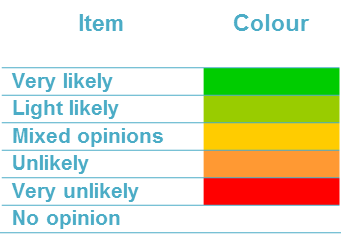
It is possible to use different visual representations to reveal:
- An overall picture of the votes;
- The proportion between participants who have judged the majority of items as very likely and the ones who have judged the majority of items as very unlikely (participants diagonal)
- The proportion between the items judged as more likely, and the ones judged as the more unlikely (hypotheses diagonal)

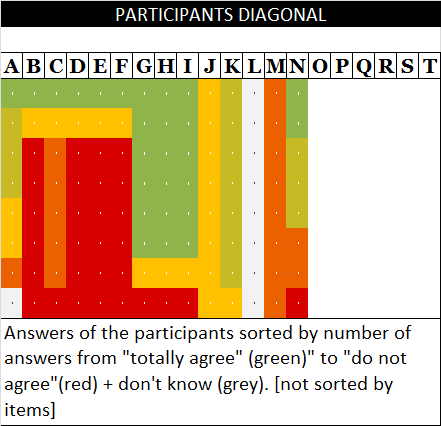
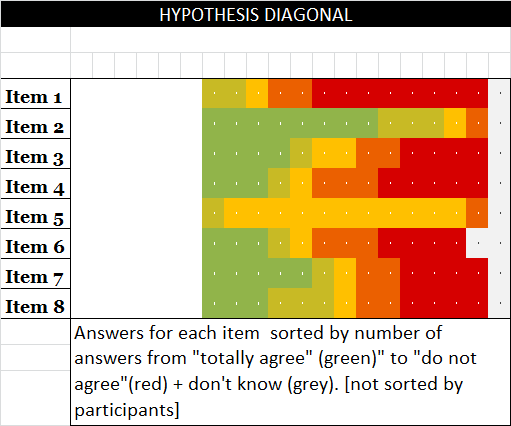
A dominant colour means a consensus while opposite colours indicate a lack of consensus.
4 >>> At the end of the workshop, participants discuss the average of each item and more particularly on the ones for which no consensus has been found. This is a good way to create links between stakeholders who can then discuss and exchange arguments. The facilitator must ensure that the discussion is constructive.

Example of visual result collected in the context of a scenario workshop about seagrass management approaches in the Gulf of Morbihan (France. More information about the case study in the section "Case studies": ![]()
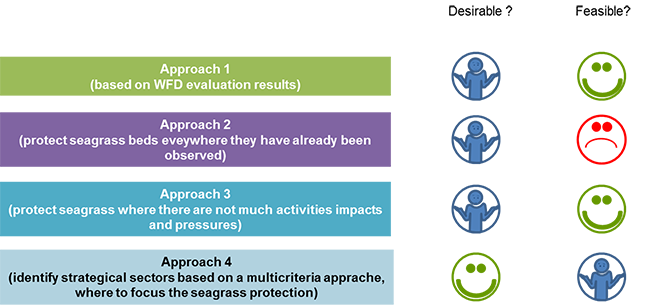
Figure: visual result of a Regnier abacus result (Manuelle Philippe)

Time: 4 hours to 1 day
Technical level: 2/4
Advantages: easy method with visual outputs; allows debate between stakeholders.
Limits: need a good organisation and time management.
Resources needed: a facilitator; a computer with Excel software.
Advice: schedule time during the workshop to enter and analyze the stakeholder’s votes.

